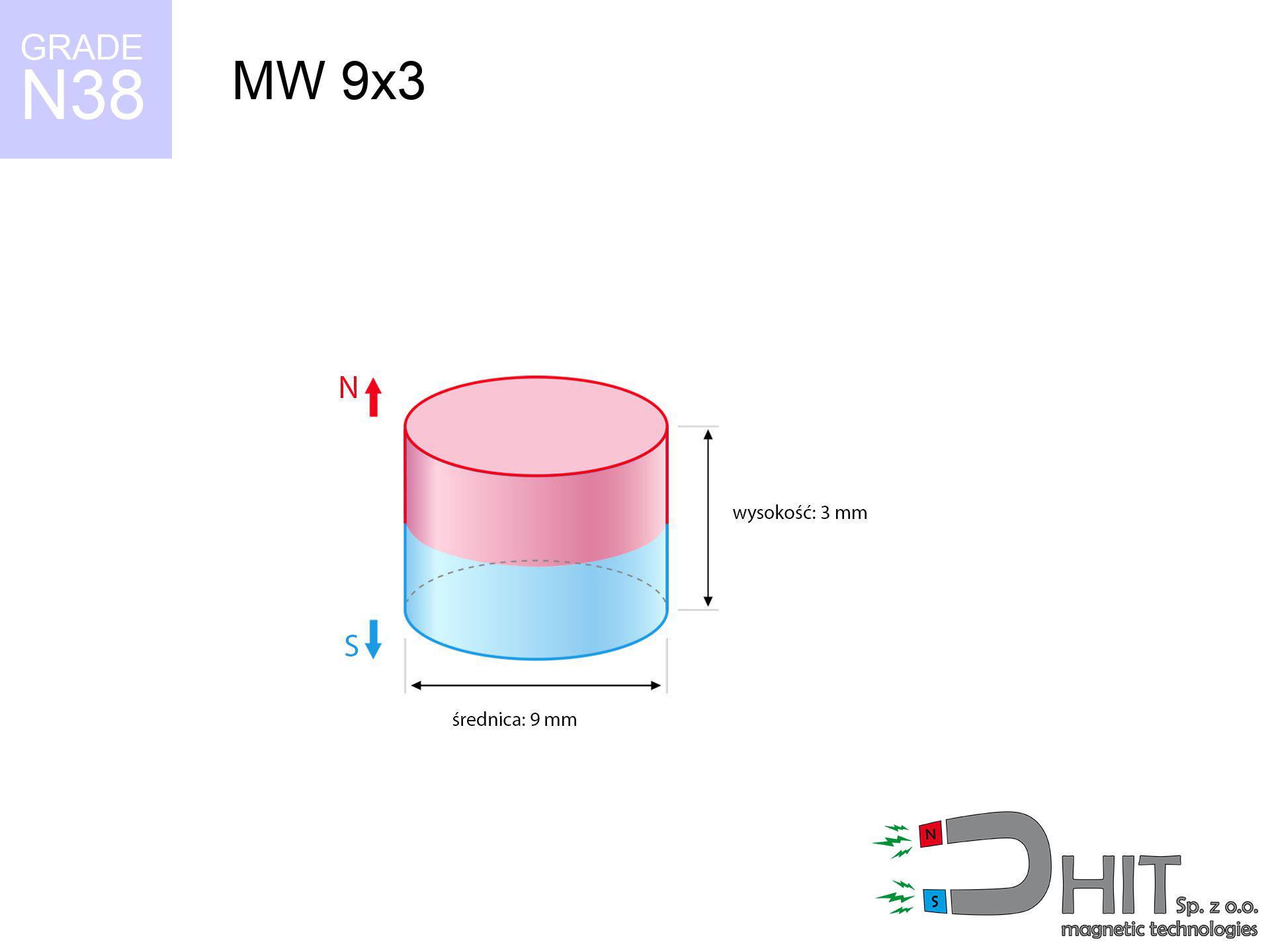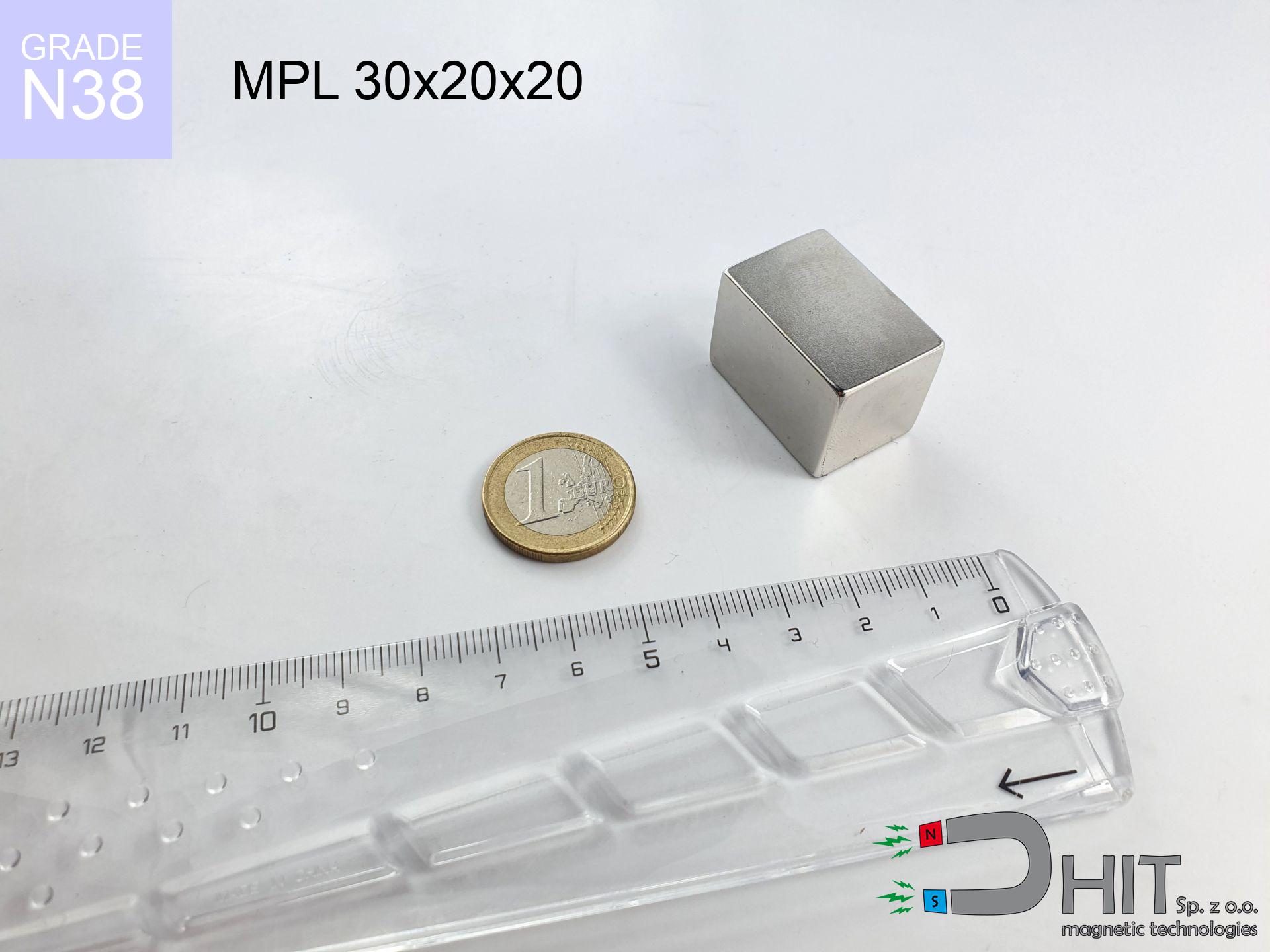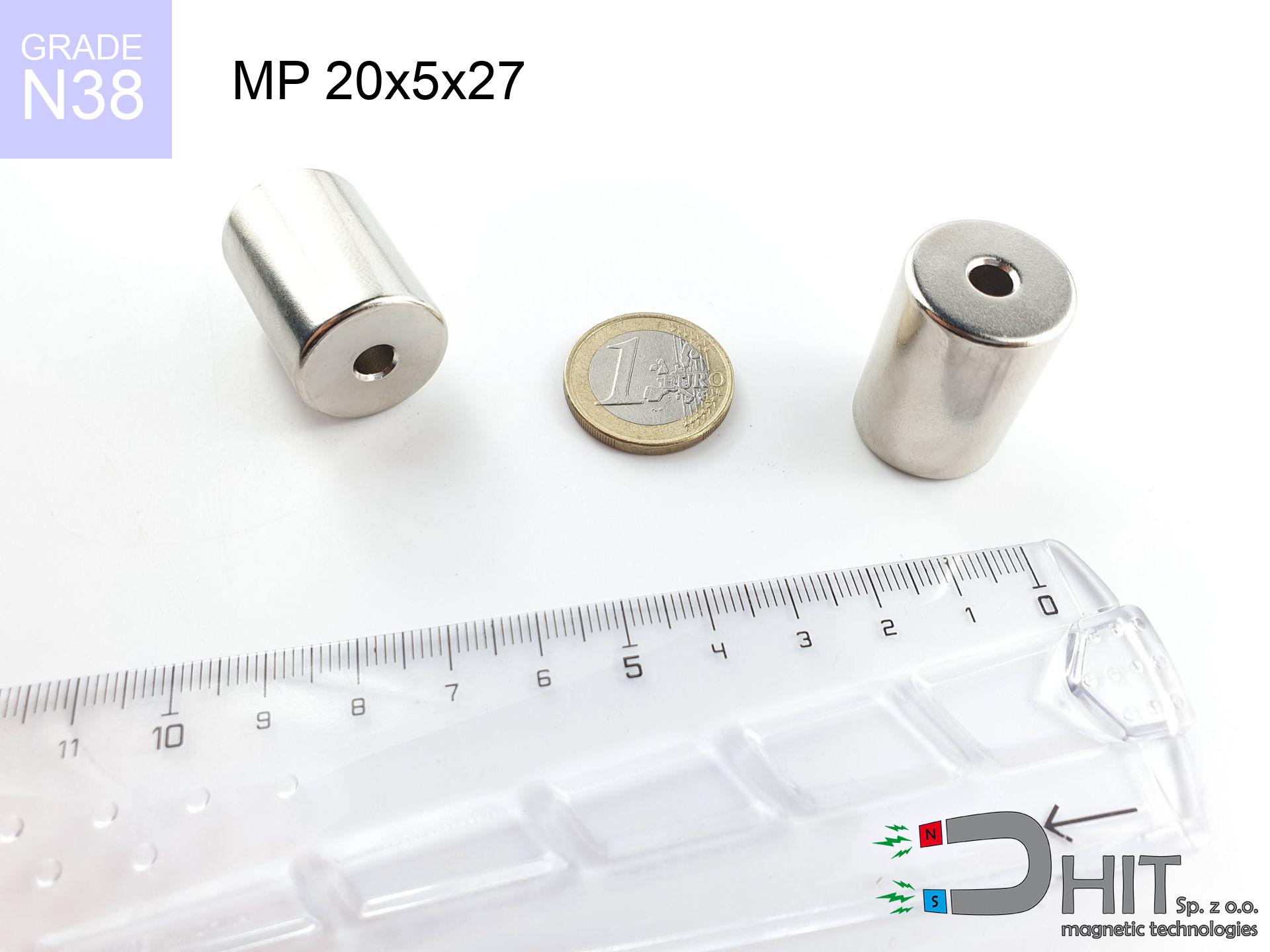MW 9x3 / N38 - cylindrical magnet
cylindrical magnet
Catalog no 010108
GTIN/EAN: 5906301811077
Diameter Ø
9 mm [±0,1 mm]
Height
3 mm [±0,1 mm]
Weight
1.43 g
Magnetization Direction
↑ axial
Load capacity
1.94 kg / 18.99 N
Magnetic Induction
343.55 mT / 3436 Gs
Coating
[NiCuNi] Nickel
1.132 ZŁ with VAT / pcs + price for transport
0.920 ZŁ net + 23% VAT / pcs
bulk discounts:
Need more?
Contact us by phone
+48 22 499 98 98
alternatively contact us via
request form
our website.
Lifting power along with form of a neodymium magnet can be calculated using our
online calculation tool.
Orders submitted before 14:00 will be dispatched today!
Technical specification of the product - MW 9x3 / N38 - cylindrical magnet
Specification / characteristics - MW 9x3 / N38 - cylindrical magnet
| properties | values |
|---|---|
| Cat. no. | 010108 |
| GTIN/EAN | 5906301811077 |
| Production/Distribution | Dhit sp. z o.o. |
| Country of origin | Poland / China / Germany |
| Customs code | 85059029 |
| Diameter Ø | 9 mm [±0,1 mm] |
| Height | 3 mm [±0,1 mm] |
| Weight | 1.43 g |
| Magnetization Direction | ↑ axial |
| Load capacity ~ ? | 1.94 kg / 18.99 N |
| Magnetic Induction ~ ? | 343.55 mT / 3436 Gs |
| Coating | [NiCuNi] Nickel |
| Manufacturing Tolerance | ±0.1 mm |
Magnetic properties of material N38
| properties | values | units |
|---|---|---|
| remenance Br [min. - max.] ? | 12.2-12.6 | kGs |
| remenance Br [min. - max.] ? | 1220-1260 | mT |
| coercivity bHc ? | 10.8-11.5 | kOe |
| coercivity bHc ? | 860-915 | kA/m |
| actual internal force iHc | ≥ 12 | kOe |
| actual internal force iHc | ≥ 955 | kA/m |
| energy density [min. - max.] ? | 36-38 | BH max MGOe |
| energy density [min. - max.] ? | 287-303 | BH max KJ/m |
| max. temperature ? | ≤ 80 | °C |
Physical properties of sintered neodymium magnets Nd2Fe14B at 20°C
| properties | values | units |
|---|---|---|
| Vickers hardness | ≥550 | Hv |
| Density | ≥7.4 | g/cm3 |
| Curie Temperature TC | 312 - 380 | °C |
| Curie Temperature TF | 593 - 716 | °F |
| Specific resistance | 150 | μΩ⋅cm |
| Bending strength | 250 | MPa |
| Compressive strength | 1000~1100 | MPa |
| Thermal expansion parallel (∥) to orientation (M) | (3-4) x 10-6 | °C-1 |
| Thermal expansion perpendicular (⊥) to orientation (M) | -(1-3) x 10-6 | °C-1 |
| Young's modulus | 1.7 x 104 | kg/mm² |
Engineering modeling of the assembly - data
These values are the outcome of a engineering analysis. Values were calculated on models for the class Nd2Fe14B. Real-world parameters might slightly differ. Treat these calculations as a supplementary guide during assembly planning.
Table 1: Static pull force (force vs gap) - characteristics
MW 9x3 / N38
| Distance (mm) | Induction (Gauss) / mT | Pull Force (kg) | Risk Status |
|---|---|---|---|
| 0 mm |
3433 Gs
343.3 mT
|
1.94 kg / 1940.0 g
19.0 N
|
weak grip |
| 1 mm |
2774 Gs
277.4 mT
|
1.27 kg / 1266.5 g
12.4 N
|
weak grip |
| 2 mm |
2090 Gs
209.0 mT
|
0.72 kg / 719.2 g
7.1 N
|
weak grip |
| 3 mm |
1521 Gs
152.1 mT
|
0.38 kg / 380.7 g
3.7 N
|
weak grip |
| 5 mm |
795 Gs
79.5 mT
|
0.10 kg / 104.1 g
1.0 N
|
weak grip |
| 10 mm |
205 Gs
20.5 mT
|
0.01 kg / 6.9 g
0.1 N
|
weak grip |
| 15 mm |
76 Gs
7.6 mT
|
0.00 kg / 1.0 g
0.0 N
|
weak grip |
| 20 mm |
36 Gs
3.6 mT
|
0.00 kg / 0.2 g
0.0 N
|
weak grip |
| 30 mm |
12 Gs
1.2 mT
|
0.00 kg / 0.0 g
0.0 N
|
weak grip |
| 50 mm |
3 Gs
0.3 mT
|
0.00 kg / 0.0 g
0.0 N
|
weak grip |
Table 2: Vertical hold (wall)
MW 9x3 / N38
| Distance (mm) | Friction coefficient | Pull Force (kg) |
|---|---|---|
| 0 mm | Stal (~0.2) |
0.39 kg / 388.0 g
3.8 N
|
| 1 mm | Stal (~0.2) |
0.25 kg / 254.0 g
2.5 N
|
| 2 mm | Stal (~0.2) |
0.14 kg / 144.0 g
1.4 N
|
| 3 mm | Stal (~0.2) |
0.08 kg / 76.0 g
0.7 N
|
| 5 mm | Stal (~0.2) |
0.02 kg / 20.0 g
0.2 N
|
| 10 mm | Stal (~0.2) |
0.00 kg / 2.0 g
0.0 N
|
| 15 mm | Stal (~0.2) |
0.00 kg / 0.0 g
0.0 N
|
| 20 mm | Stal (~0.2) |
0.00 kg / 0.0 g
0.0 N
|
| 30 mm | Stal (~0.2) |
0.00 kg / 0.0 g
0.0 N
|
| 50 mm | Stal (~0.2) |
0.00 kg / 0.0 g
0.0 N
|
Table 3: Wall mounting (sliding) - behavior on slippery surfaces
MW 9x3 / N38
| Surface type | Friction coefficient / % Mocy | Max load (kg) |
|---|---|---|
| Raw steel |
µ = 0.3
30% Nominalnej Siły
|
0.58 kg / 582.0 g
5.7 N
|
| Painted steel (standard) |
µ = 0.2
20% Nominalnej Siły
|
0.39 kg / 388.0 g
3.8 N
|
| Oily/slippery steel |
µ = 0.1
10% Nominalnej Siły
|
0.19 kg / 194.0 g
1.9 N
|
| Magnet with anti-slip rubber |
µ = 0.5
50% Nominalnej Siły
|
0.97 kg / 970.0 g
9.5 N
|
Table 4: Steel thickness (substrate influence) - sheet metal selection
MW 9x3 / N38
| Steel thickness (mm) | % power | Real pull force (kg) |
|---|---|---|
| 0.5 mm |
|
0.19 kg / 194.0 g
1.9 N
|
| 1 mm |
|
0.49 kg / 485.0 g
4.8 N
|
| 2 mm |
|
0.97 kg / 970.0 g
9.5 N
|
| 5 mm |
|
1.94 kg / 1940.0 g
19.0 N
|
| 10 mm |
|
1.94 kg / 1940.0 g
19.0 N
|
Table 5: Working in heat (material behavior) - thermal limit
MW 9x3 / N38
| Ambient temp. (°C) | Power loss | Remaining pull | Status |
|---|---|---|---|
| 20 °C | 0.0% |
1.94 kg / 1940.0 g
19.0 N
|
OK |
| 40 °C | -2.2% |
1.90 kg / 1897.3 g
18.6 N
|
OK |
| 60 °C | -4.4% |
1.85 kg / 1854.6 g
18.2 N
|
|
| 80 °C | -6.6% |
1.81 kg / 1812.0 g
17.8 N
|
|
| 100 °C | -28.8% |
1.38 kg / 1381.3 g
13.6 N
|
Table 6: Two magnets (repulsion) - forces in the system
MW 9x3 / N38
| Gap (mm) | Attraction (kg) (N-S) | Repulsion (kg) (N-N) |
|---|---|---|
| 0 mm |
4.62 kg / 4623 g
45.4 N
4 949 Gs
|
N/A |
| 1 mm |
3.82 kg / 3822 g
37.5 N
6 244 Gs
|
3.44 kg / 3440 g
33.7 N
~0 Gs
|
| 2 mm |
3.02 kg / 3018 g
29.6 N
5 548 Gs
|
2.72 kg / 2716 g
26.6 N
~0 Gs
|
| 3 mm |
2.30 kg / 2303 g
22.6 N
4 847 Gs
|
2.07 kg / 2073 g
20.3 N
~0 Gs
|
| 5 mm |
1.25 kg / 1253 g
12.3 N
3 575 Gs
|
1.13 kg / 1128 g
11.1 N
~0 Gs
|
| 10 mm |
0.25 kg / 248 g
2.4 N
1 591 Gs
|
0.22 kg / 223 g
2.2 N
~0 Gs
|
| 20 mm |
0.02 kg / 16 g
0.2 N
410 Gs
|
0.01 kg / 15 g
0.1 N
~0 Gs
|
| 50 mm |
0.00 kg / 0 g
0.0 N
39 Gs
|
0.00 kg / 0 g
0.0 N
~0 Gs
|
Table 7: Protective zones (electronics) - precautionary measures
MW 9x3 / N38
| Object / Device | Limit (Gauss) / mT | Safe distance |
|---|---|---|
| Pacemaker | 5 Gs (0.5 mT) | 4.5 cm |
| Hearing aid | 10 Gs (1.0 mT) | 3.5 cm |
| Mechanical watch | 20 Gs (2.0 mT) | 2.5 cm |
| Phone / Smartphone | 40 Gs (4.0 mT) | 2.0 cm |
| Car key | 50 Gs (5.0 mT) | 2.0 cm |
| Payment card | 400 Gs (40.0 mT) | 1.0 cm |
| HDD hard drive | 600 Gs (60.0 mT) | 1.0 cm |
Table 8: Dynamics (kinetic energy) - collision effects
MW 9x3 / N38
| Start from (mm) | Speed (km/h) | Energy (J) | Predicted outcome |
|---|---|---|---|
| 10 mm |
37.23 km/h
(10.34 m/s)
|
0.08 J | |
| 30 mm |
64.34 km/h
(17.87 m/s)
|
0.23 J | |
| 50 mm |
83.06 km/h
(23.07 m/s)
|
0.38 J | |
| 100 mm |
117.47 km/h
(32.63 m/s)
|
0.76 J |
Table 9: Anti-corrosion coating durability
MW 9x3 / N38
| Technical parameter | Value / Description |
|---|---|
| Coating type | [NiCuNi] Nickel |
| Layer structure | Nickel - Copper - Nickel |
| Layer thickness | 10-20 µm |
| Salt spray test (SST) ? | 24 h |
| Recommended environment | Indoors only (dry) |
Table 10: Construction data (Pc)
MW 9x3 / N38
| Parameter | Value | SI Unit / Description |
|---|---|---|
| Magnetic Flux | 2 314 Mx | 23.1 µWb |
| Pc Coefficient | 0.44 | Low (Flat) |
Table 11: Hydrostatics and buoyancy
MW 9x3 / N38
| Environment | Effective steel pull | Effect |
|---|---|---|
| Air (land) | 1.94 kg | Standard |
| Water (riverbed) |
2.22 kg
(+0.28 kg Buoyancy gain)
|
+14.5% |
1. Wall mount (shear)
*Caution: On a vertical wall, the magnet retains only a fraction of its perpendicular strength.
2. Plate thickness effect
*Thin steel (e.g. computer case) significantly weakens the holding force.
3. Power loss vs temp
*For N38 material, the critical limit is 80°C.
4. Demagnetization curve and operating point (B-H)
chart generated for the permeance coefficient Pc (Permeance Coefficient) = 0.44
The chart above illustrates the magnetic characteristics of the material within the second quadrant of the hysteresis loop. The solid red line represents the demagnetization curve (material potential), while the dashed blue line is the load line based on the magnet's geometry. The Pc (Permeance Coefficient), also known as the load line slope, is a dimensionless value that describes the relationship between the magnet's shape and its magnetic stability. The intersection of these two lines (the black dot) is the operating point — it determines the actual magnetic flux density generated by the magnet in this specific configuration. A higher Pc value means the magnet is more 'slender' (tall relative to its area), resulting in a higher operating point and better resistance to irreversible demagnetization caused by external fields or temperature. A value of 0.42 is relatively low (typical for flat magnets), meaning the operating point is closer to the 'knee' of the curve — caution is advised when operating at temperatures near the maximum limit to avoid strength loss.
Elemental analysis
| iron (Fe) | 64% – 68% |
| neodymium (Nd) | 29% – 32% |
| boron (B) | 1.1% – 1.2% |
| dysprosium (Dy) | 0.5% – 2.0% |
| coating (Ni-Cu-Ni) | < 0.05% |
Sustainability
| recyclability (EoL) | 100% |
| recycled raw materials | ~10% (pre-cons) |
| carbon footprint | low / zredukowany |
| waste code (EWC) | 16 02 16 |
View also products
Pros and cons of Nd2Fe14B magnets.
Strengths
- They have constant strength, and over nearly 10 years their performance decreases symbolically – ~1% (according to theory),
- Magnets very well defend themselves against demagnetization caused by foreign field sources,
- In other words, due to the metallic finish of gold, the element looks attractive,
- They feature high magnetic induction at the operating surface, which affects their effectiveness,
- Made from properly selected components, these magnets show impressive resistance to high heat, enabling them to function (depending on their form) at temperatures up to 230°C and above...
- Thanks to flexibility in constructing and the ability to customize to specific needs,
- Universal use in electronics industry – they are used in computer drives, motor assemblies, diagnostic systems, and complex engineering applications.
- Relatively small size with high pulling force – neodymium magnets offer impressive pulling force in compact dimensions, which enables their usage in small systems
Cons
- They are prone to damage upon heavy impacts. To avoid cracks, it is worth protecting magnets in special housings. Such protection not only shields the magnet but also improves its resistance to damage
- When exposed to high temperature, neodymium magnets suffer a drop in force. Often, when the temperature exceeds 80°C, their power decreases (depending on the size and shape of the magnet). For those who need magnets for extreme conditions, we offer [AH] versions withstanding up to 230°C
- Due to the susceptibility of magnets to corrosion in a humid environment, we advise using waterproof magnets made of rubber, plastic or other material resistant to moisture, when using outdoors
- Due to limitations in producing nuts and complicated shapes in magnets, we propose using cover - magnetic mount.
- Health risk related to microscopic parts of magnets can be dangerous, when accidentally swallowed, which is particularly important in the context of child health protection. It is also worth noting that small elements of these magnets are able to complicate diagnosis medical after entering the body.
- With mass production the cost of neodymium magnets can be a barrier,
Holding force characteristics
Optimal lifting capacity of a neodymium magnet – what contributes to it?
- on a base made of mild steel, effectively closing the magnetic flux
- with a cross-section no less than 10 mm
- with an polished touching surface
- with zero gap (without paint)
- for force applied at a right angle (in the magnet axis)
- in temp. approx. 20°C
Lifting capacity in real conditions – factors
- Space between magnet and steel – even a fraction of a millimeter of separation (caused e.g. by varnish or unevenness) drastically reduces the magnet efficiency, often by half at just 0.5 mm.
- Loading method – declared lifting capacity refers to detachment vertically. When attempting to slide, the magnet exhibits much less (typically approx. 20-30% of nominal force).
- Wall thickness – thin material does not allow full use of the magnet. Magnetic flux penetrates through instead of converting into lifting capacity.
- Material type – the best choice is high-permeability steel. Hardened steels may generate lower lifting capacity.
- Smoothness – full contact is possible only on polished steel. Rough texture reduce the real contact area, weakening the magnet.
- Temperature influence – hot environment weakens pulling force. Exceeding the limit temperature can permanently demagnetize the magnet.
Lifting capacity testing was conducted on plates with a smooth surface of optimal thickness, under perpendicular forces, whereas under shearing force the lifting capacity is smaller. Additionally, even a minimal clearance between the magnet’s surface and the plate reduces the load capacity.
Warnings
Mechanical processing
Machining of neodymium magnets carries a risk of fire hazard. Magnetic powder oxidizes rapidly with oxygen and is difficult to extinguish.
Bone fractures
Pinching hazard: The attraction force is so immense that it can cause blood blisters, pinching, and even bone fractures. Protective gloves are recommended.
Nickel coating and allergies
A percentage of the population suffer from a contact allergy to Ni, which is the standard coating for NdFeB magnets. Frequent touching can result in a rash. We strongly advise wear protective gloves.
Caution required
Handle with care. Rare earth magnets attract from a long distance and snap with huge force, often faster than you can react.
Heat sensitivity
Regular neodymium magnets (grade N) undergo demagnetization when the temperature surpasses 80°C. The loss of strength is permanent.
Shattering risk
Neodymium magnets are sintered ceramics, which means they are prone to chipping. Collision of two magnets leads to them cracking into small pieces.
Keep away from children
Strictly store magnets away from children. Risk of swallowing is high, and the consequences of magnets connecting inside the body are life-threatening.
GPS Danger
A strong magnetic field negatively affects the operation of magnetometers in smartphones and navigation systems. Do not bring magnets near a device to avoid breaking the sensors.
Medical interference
People with a heart stimulator must maintain an safe separation from magnets. The magnetism can interfere with the functioning of the implant.
Magnetic media
Avoid bringing magnets close to a wallet, computer, or TV. The magnetic field can irreversibly ruin these devices and wipe information from cards.






![UMP 97x40 [M8+M10] GW F300 Lina / N38 - search holder UMP 97x40 [M8+M10] GW F300 Lina / N38 - search holder](https://cdn3.dhit.pl/graphics/products/ump-97x40-m8+m10-gw-f300-+lina-ful.jpg)


